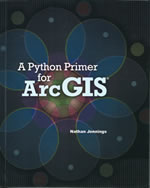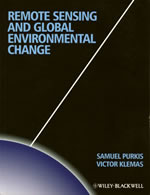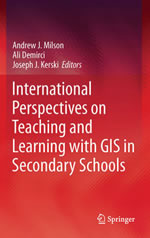ArcUser
Spring 2012 Edition
GIS Bookshelf
This article as a PDF.
A Python Primer for ArcGIS
By Nathan Jennings
 This workbook was written with the GIS user in mind. Rather than a text on the Python language, it is an introduction to using Python for ArcGIS geoprocesses. Written for ArcGIS 10, it teaches how to develop stand-alone Python scripts that accomplish geoprocessing tasks and can be run both inside and outside ArcGIS. It provides a systematic method for learning the elements of Python programming used in ArcGIS. The author, Nathan Jennings, is a full-time GIS professional with the City of Sacramento, California, who teaches courses in GIS programming, remote sensing, web map application development, GPS, and GIS software at American River and Sacramento City Colleges. CreateSpace, 2011, 458 pp., ISBN: 978-1466274594
This workbook was written with the GIS user in mind. Rather than a text on the Python language, it is an introduction to using Python for ArcGIS geoprocesses. Written for ArcGIS 10, it teaches how to develop stand-alone Python scripts that accomplish geoprocessing tasks and can be run both inside and outside ArcGIS. It provides a systematic method for learning the elements of Python programming used in ArcGIS. The author, Nathan Jennings, is a full-time GIS professional with the City of Sacramento, California, who teaches courses in GIS programming, remote sensing, web map application development, GPS, and GIS software at American River and Sacramento City Colleges. CreateSpace, 2011, 458 pp., ISBN: 978-1466274594
Remote Sensing and Global Environmental Change
By Sam J. Purkis and Victor V. Klemas
 Rather than providing extensive information on sensor specifications and operation, this book presents the fundamentals of remote-sensing technology and concentrates on the application of this technology in assessing the health of atmosphere, cryosphere, oceans, coastal areas, freshwater systems, and land cover and devotes a chapter to each. The target audience for this book is advanced undergraduate and graduate students in earth science, environmental science, or physical geography. However, it is a valuable reference for GIS professionals who use remote-sensing data for monitoring and mapping environmental change at regional and global scales. Wiley-Blackwell, 2011, 384 pp., ISBN: 978-1405182256
Rather than providing extensive information on sensor specifications and operation, this book presents the fundamentals of remote-sensing technology and concentrates on the application of this technology in assessing the health of atmosphere, cryosphere, oceans, coastal areas, freshwater systems, and land cover and devotes a chapter to each. The target audience for this book is advanced undergraduate and graduate students in earth science, environmental science, or physical geography. However, it is a valuable reference for GIS professionals who use remote-sensing data for monitoring and mapping environmental change at regional and global scales. Wiley-Blackwell, 2011, 384 pp., ISBN: 978-1405182256
International Perspectives on Teaching and Learning with GIS in Secondary Schools
Edited by Andrew J. Milson, Ali Demirci, and Joseph Kerski
 This book is the first publication to provide an international perspective on the pedagogical value of GIS technology in classrooms and offer a range of views on the subject. This book provides a truly global perspective: authors from 33 countries contributed, and countries from six continents are represented. GIS has revolutionized the way people explore and understand the world around them, and its effects are felt in the classroom. Instructors are using this technology in secondary-school classrooms worldwide to teach social and scientific concepts and processes, broaden students' technical skills, and sharpen problem-solving skills. Each country chapter includes a summary of the country's educational context, a case study illustrating how GIS is used in secondary schooling, and an assessment of the opportunities and challenges in teaching and learning with GIS now and in the future. The book ends with some reflections on the progress made in teaching and learning with GIS over the past 20 years, key trends for the remainder of this decade, and recommendations for meeting the goal of engaging all students in thinking spatially. Springer, 2012, 353 pp., ISBN: 978-9400721197
This book is the first publication to provide an international perspective on the pedagogical value of GIS technology in classrooms and offer a range of views on the subject. This book provides a truly global perspective: authors from 33 countries contributed, and countries from six continents are represented. GIS has revolutionized the way people explore and understand the world around them, and its effects are felt in the classroom. Instructors are using this technology in secondary-school classrooms worldwide to teach social and scientific concepts and processes, broaden students' technical skills, and sharpen problem-solving skills. Each country chapter includes a summary of the country's educational context, a case study illustrating how GIS is used in secondary schooling, and an assessment of the opportunities and challenges in teaching and learning with GIS now and in the future. The book ends with some reflections on the progress made in teaching and learning with GIS over the past 20 years, key trends for the remainder of this decade, and recommendations for meeting the goal of engaging all students in thinking spatially. Springer, 2012, 353 pp., ISBN: 978-9400721197